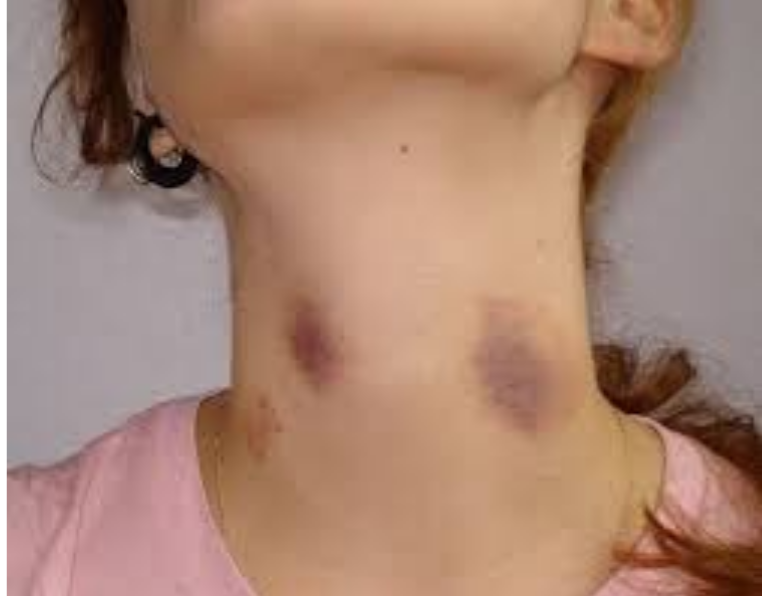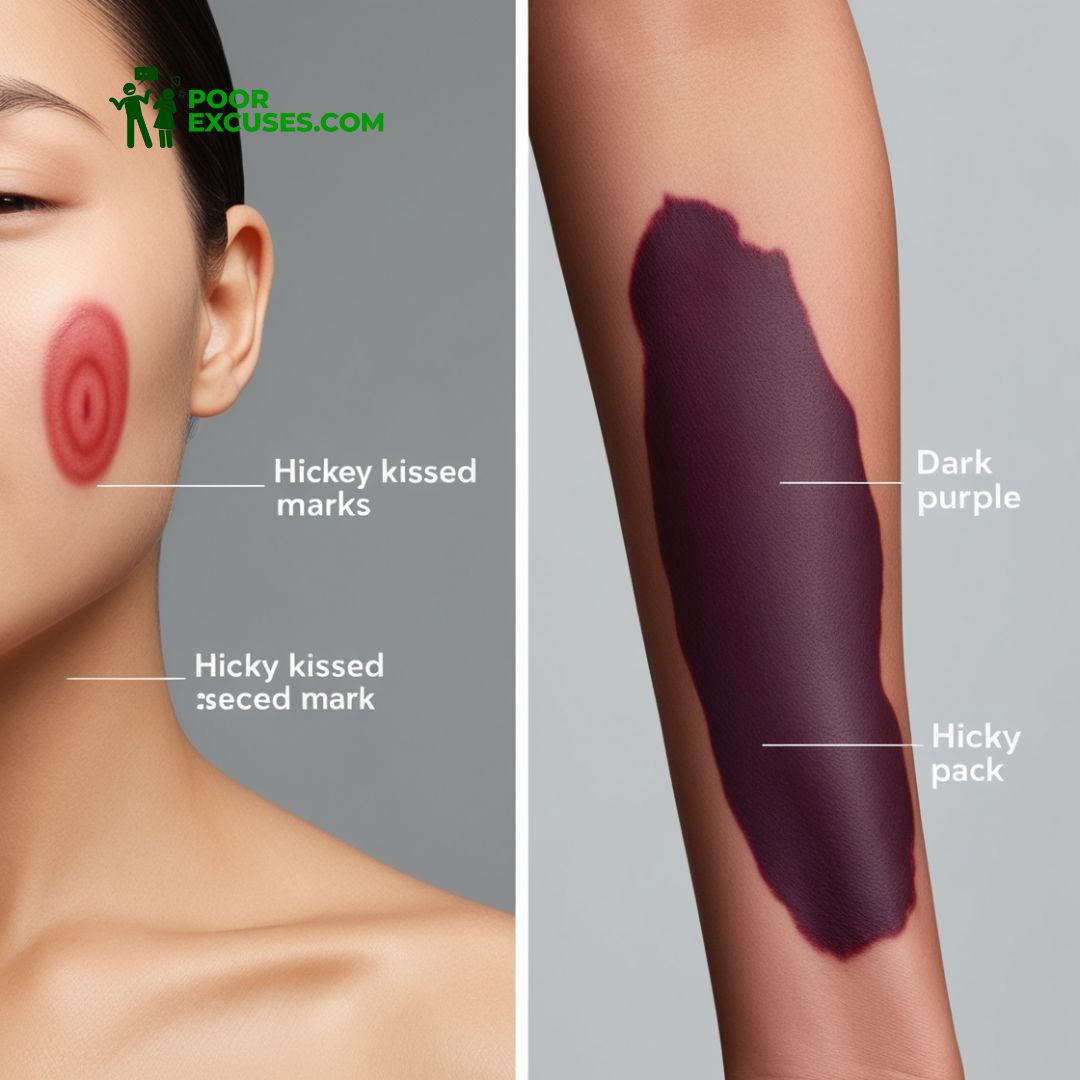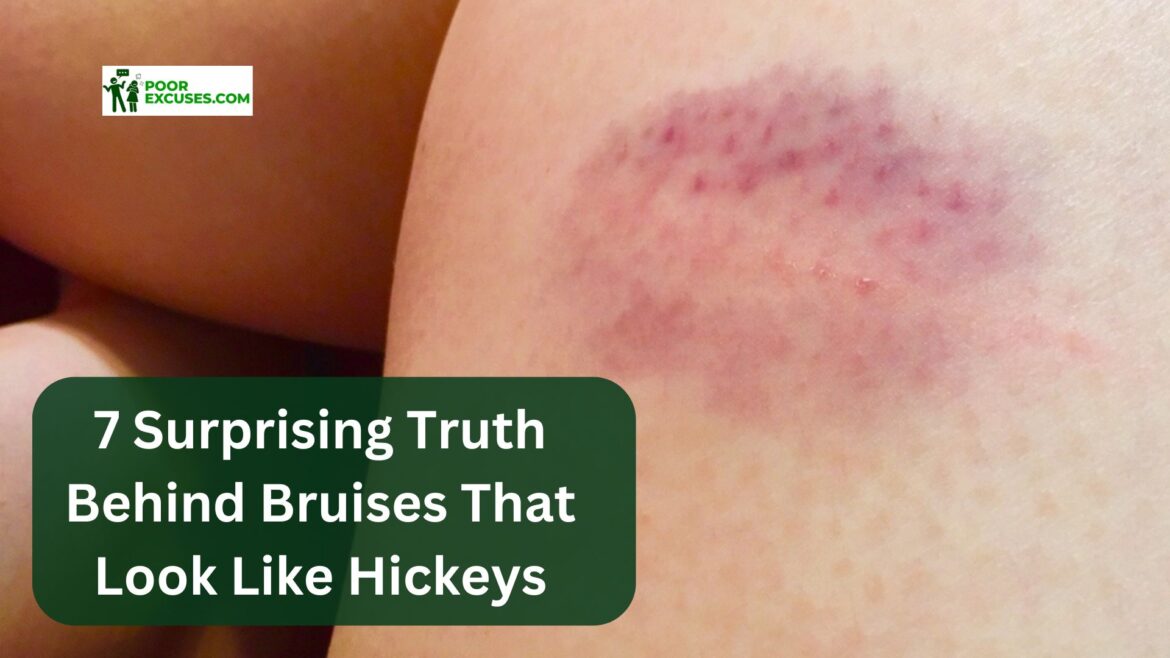You’re at a party, and someone notices a mark on your neck. With a nervous laugh, you say, “Oh, it’s just a bruise! Not a hickey!”
This leads to an interesting question: how can we tell the difference between bruises that look like hickeys? It’s a common scenario that many people can relate to. Have you ever thought about what those marks mean?
They can be confusing, and sometimes, they raise eyebrows. Are they just from bumping into something, or could they be a sign of something more serious?
You don’t want to misinterpret a bruise as something more serious or vice versa! So, stick around as we explore the differences, how to take care of each, and why knowing what’s what matters. You won’t want to miss the tips at the end that can help you avoid any mix-ups!
Understanding Bruises and Hickeys

What Are Bruises?
Let’s start with bruises. Bruises are those colorful marks you get when you bump into something.
When you hit your arm or leg, tiny blood vessels break under your skin. This causes blood to leak out, creating that dark spot we all know.
They usually change colors as they heal, going from dark purple to yellow. It’s all part of the body’s way of healing itself.
How Are Hickeys Formed?
Now, let’s talk about hickeys. They can look a lot like bruises, but they come from a different cause. Hickeys happen when someone sucks or bites on your skin.
This creates trauma to the surface of blood vessels, causing them to break and leave a mark. It’s a bit like giving your skin a love tap, but it can leave a noticeable mark!
So, when you see bruises that look like hickeys, it can get a little confusing. Are they from a playful moment or an accidental bump? Knowing the difference is important, especially when it comes to how you care for them.
Why It Matters
Understanding the difference can help you know when to seek help or when to simply let it be. And that’s just the beginning! Stick around, because we’re about to explore how to treat both of these marks and when you might need to pay extra attention to them. You won’t want to miss these helpful tips!
7 Surprising Truths Behind Bruises That Look Like Hickeys
Hickeys, often called “love bites,” can appear suddenly on your neck or in other areas, and they can be a bit confusing. Here are seven surprising truths about bruises that look like hickeys that you might want to know!

1. What Causes Bruises That Look Like Hickeys?
Bruises that resemble hickeys can form from various causes, including impact or trauma. When blood vessels break beneath the skin, it leads to discoloration, often resembling a hickey. Understanding the cause helps differentiate between the two.
2. How Long Do These Bruises Last?
Like hickeys, these bruises typically heal in about 1-2 weeks. They often start as dark red, change to purple, and eventually fade to yellow. If you notice a bruise lingering longer than that, it might be worth checking with a doctor.
3. Tips for Concealing a Bruise
Want to hide a bruise that looks like a hickey? Applying a cold compress right after the injury can help reduce swelling. After 48 hours, switch to a warm compress to promote healing and make the mark less noticeable.
4. Home Remedies That Work
Home remedies can effectively soothe bruises. Aloe vera is great for reducing swelling, while arnica cream helps with bruising. Additionally, using vitamin C cream can support skin health and recovery.
5. The Stages of Bruise Healing
Understanding the healing stages of a bruise can help you know what to expect. Initially, it may appear dark red or purple due to fresh bleeding, eventually fading to yellow or green as it heals. If you notice unusual changes, seek medical advice.
6. How Technique Matters
Sometimes, the method of how the bruise occurred can affect its appearance. For example, a hard impact can create a more pronounced mark, while a light bump may result in a less visible bruise. This can lead to confusion with hickeys.
7. Symptoms to Monitor
While bruises that look like hickeys are usually harmless, keep an eye out for symptoms like increased swelling or pain. Applying an ice pack can help alleviate discomfort. If concerns persist, don’t hesitate to consult a doctor.
Since you know some surprising truths about bruises that look like hickeys! If you’re curious about how to heal them or just want to understand them better, these tips can help. Taking care of your skin is important, so keep these tips in mind for a speedy recovery!
Common Causes of Bruises That Look Like Hickeys
Skin Conditions That Mimic Hickeys
It’s not just bumps and love bites that can leave marks on your skin. Some skin conditions can look a lot like hickeys, which can confuse things. Let’s take a closer look at a few of these conditions.
Eczema: This is a common skin condition that causes red, itchy patches. Sometimes, when you scratch the irritated skin, it can lead to bruising or darker spots that resemble hickeys.
Psoriasis: This condition leads to thick, scaly patches on the skin. If these patches get inflamed or scratched, they might look like hickeys too, especially if they’re reddish.
Dermatitis: This is another term for skin inflammation, which can result from irritants or allergens. It can cause redness and swelling, making the skin look like it’s been marked.
Non-Injury-Related Causes
Now, let’s talk about some non-injury-related causes that can also resemble hickeys:
- Petechiae: These are tiny, flat red or purple spots caused by bleeding under the skin. They can appear anywhere on the body and might look like little hickeys.
- Purpura: Similar to petechiae, purpura are larger spots that also indicate bleeding under the skin. They can be a sign of various health issues, so it’s important to take note if you see them.
Medical Issues to Consider
Some medical conditions can cause marks similar to hickeys:
- Lupus: This autoimmune disease can cause a variety of skin changes, including rashes that might look like hickeys.
- Urticaria (Hives): These are raised, itchy welts that can appear anywhere on the body. Sometimes, they can look like hickeys, especially if they’re clustered together.
The Skin Conditions That Can Cause Marks
Understanding these skin conditions can help when you’re trying to figure out what those marks on your skin might be. Whether it’s eczema, psoriasis, or dermatitis, knowing the signs can make a big difference.
It’s fascinating how the skin can tell us so much about our health! If you ever notice something unusual, don’t hesitate to ask a healthcare professional.
Now that we’ve covered various conditions that can create confusion, let’s dig deeper into how to properly identify and treat bruises and hickeys. Knowing what you’re dealing with will help you take the right steps for care!
How to Differentiate Between a Hickey and a Bruise
When you spot a mark on your skin, it’s important to know whether it’s a hickey or a bruise. Understanding the key characteristics can help you identify what you’re dealing with.

Key Characteristics
- Color and Appearance:
- Hickeys: Usually start as a bright red or purple mark and may fade to a lighter color over a few days. They have a distinct shape, often oval or circular, and can have a smooth appearance.
- Bruises: Begin as red or purple but change colors as they heal, often turning blue, green, or yellow. They can be more irregular in shape, depending on the impact.
- Location:
- Hickeys: Often found on areas like the neck, shoulders, or other visible spots where skin is softer and more exposed.
- Bruises: Can occur anywhere on the body, especially on areas prone to bumps or impacts, like arms and legs.
- Tenderness:
- Hickeys: May feel tender or sensitive to the touch, but usually, they don’t cause pain unless the area was bitten or sucked too hard.
- Bruises: Often painful, especially when touched, due to the underlying tissue damage.
Visual Comparisons
While it’s best to look at images, here’s a simple way to visualize the differences:
Hickey: Picture a smooth, circular red mark that looks like a kiss. It has a bright color at first and fades gradually.
Bruise: Assumine a rougher patch of color that changes from purple to green to yellow. It might look more irregular and have an uneven surface.
Tips for Observation
a. Check the Area: Look closely at where the mark is located. If it’s on the neck and has a distinct shape, it’s likely a hickey. If it’s on the leg and irregular, it’s probably a bruise.
b. Feel the Mark: Gently touch the area. If it’s painful, it’s more likely a bruise. If it’s just sensitive, it could be a hickey.
c. Watch for Changes: Over the next few days, observe how the mark changes. Hickeys will fade uniformly, while bruises will show a wider range of colors as they heal.
By keeping these characteristics in mind, you can easily tell the difference between a hickey and a bruise.
Now that you know how to differentiate between the two, let’s explore some effective ways to treat both bruises and hickeys. Understanding treatment options will help you take care of your skin and ensure it heals properly!
The Importance of Seeking Medical Advice
It’s really important to know when to see a doctor about unusual skin marks. If you notice a mark that doesn’t look like a typical bruise or hickey, especially if it changes over time, it’s worth getting checked out. Misdiagnosing something that looks like a hickey could lead to overlooking a more serious issue.
For example, if a bruise appears without any known cause or if it doesn’t fade like a regular bruise should, that’s a sign to talk to a healthcare professional. Your skin is trying to tell you something, and it’s better to be safe than sorry!
Petechiae and Purpura: What You Need to Know
Have you heard of petechiae and purpura? These are two types of marks that can sometimes look like hickeys.
- Petechiae are tiny, flat red or purple spots on the skin. They happen when small blood vessels break, often due to strain, like coughing or sneezing.
- Purpura are larger spots that also indicate bleeding under the skin.
Both of these can appear anywhere and may need medical attention. They can be caused by various factors, including certain medical conditions. If you see these marks, especially if they pop up suddenly or are accompanied by other symptoms, it’s important to consult a doctor.
Medical Conditions That May Cause Similar Marks
Some health issues can cause marks that look like hickeys, too. Conditions like lupus and urticaria (also known as hives) can create skin changes that resemble hickeys.
- Lupus can lead to rashes and other skin changes, so if you notice a mark and also feel tired or have joint pain, it’s a good idea to check in with a doctor.
- Urticaria causes raised, itchy welts that can look similar to hickeys. If you notice a lot of itching along with these marks, getting medical advice is key.
Watch for other symptoms, like fever or unexplained fatigue, as these could signal a need for medical help.
When to Seek Medical Advice
It’s crucial to know the red flags for unusual skin marks. If you notice marks that don’t go away or change in ways that worry you, don’t hesitate to see a healthcare professional.
Persistent symptoms, like swelling, pain, or fever, are strong indicators that you should seek help. Remember, it’s always better to be cautious!
Final Thought
Understanding bruises that look like hickeys is vital for proper identification and treatment. Being proactive about your skin health can make a huge difference. If something seems off, don’t wait—get the help you need!
Have you ever had a mark that you weren’t sure about? Share your experiences or questions in the comments! Let’s learn from each other and keep our skin healthy together.


